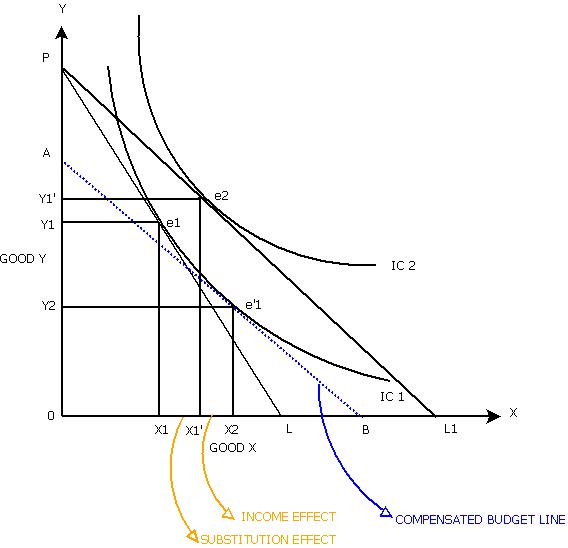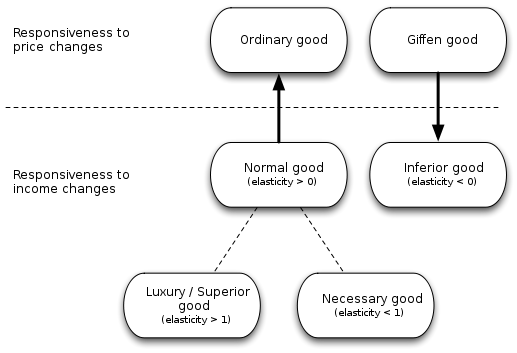User:Manish gogari/My Sandbox
| Concept of Giffen's Paradox |
In case of Giffen goods quantity demanded will vary directly with price. Again an increase in income will generally cause the consumption of most goods to increase. But there are a few goods for which the pattern is reversed. It means an increase in income causes a decrease in consumption. Here for a good to be Giffen, the income effect must dominate the substitution effect.
| According to J.R. Hicks, for a good to be a Giffen good, following three conditions are essential: |
1. The good must be inferior with strong negative income effect.
2. The substitution effect must be small.
3. The proportion of income spent for the inferior good must be very large.
Diagrammatic Representation of Giffen Goods:
Explanation of the Diagram:
Most students find it very frustrating to illustrate the case of a Giffen good using indifference curves and budget lines because rarely does a diagram come out right the first time. There are two goods, X and Y, and we want to show that X is a Giffen good, i.e., a decrease in its price would cause its consumption to fall. The Substitution Effect occurs when with fall in price, the quantity increases; with adjusting income in such a way that the real purchasing power of the consumer remains the same as before.It is called as 'Compensatory variation in income'.It isolates substitution effect. In the above diagram, AB price line depicts the compensated budget line.AB price line is tangent to the IC1 at point e'1.When Income effect is positive and very strong then there is exception to the law of demand;that is the case of Giffen goods.
For advanced students, the reason why this would work can be given. Recall the Slutsky equation.( Refer: Decomposition of Price Effect: Giffen Goods by Dr Rekha Mahadeshwar Break Up) where the income effect (which is responsible for the perverse effect) is proportional to the budget share of the good. By locating e1 very close to the horizontal axis, we make this share large and, hence, increase the likelihood that the good would come out Giffen.
Refer: Tran Huu Dung, Wright State University[[1]
| Do such goods ever exist?
1.Legend describes the Irish potato famine as a possible example of Giffen Goods. In the apocryphal example of the Irish famine, the rising price of potatoes so squeezed family incomes that they had to give up nicer but less essential foods and buy more essentials, a dietary staple - namely potatoes. 2. A new study by Robert Jensen and Nolan Miller, economists at Harvard's Kennedy School, answers this question in the affirmative: 'we conducted a field experiment in which for five months, randomly selected households were given vouchers that subsidized their purchases of their primary dietary staple. Building on the insights of our earlier analysis, we studied province of China: Hunan in the south, where rice is the staple good. Using consumption surveys gathered before, during and after the subsidy was imposed, we find strong evidence that poor households in Hunan exhibit Giffen behavior with respect to rice. That is, lowering the price of rice via the experimental subsidy caused households to reduce their demand for rice, and removing the subsidy had the opposite effect.' |

|
Activity |
| Try this QUIZ | |
| Example: {{{Example}}} |
|

|
Self-Assessment Questions (SAQs) {{{n}}} |
| {{{SAQ}}} | |

|
Results |
In case of Giffen goods,both Price Effect and Income Effect are negative.
The negative Income Effect is stronger to outweigh the Positive substitution Effect.
Giffen goods are exception to the Law of Demand.

|
Key Terms |
Source:Wikipidia

|
References and Bibliography |

|
Further Readings |


